Nuremberg trials
In the Nuremberg Trial of the Major War Criminals, or Nuremberg Trial of the Major War Criminals, German politicians, military officers, and Nazi officials were held criminally responsible for the first time after World War II for the planning, preparation, initiation, and execution of a war of aggression, crimes against the civilian population and prisoners of war, and mass murder in the extermination camps. Of the twenty-four defendants, twelve were sentenced to death and seven to imprisonment, while three defendants were acquitted. Two cases were dismissed without conviction.
This trial was the first of the thirteen Nuremberg Trials. The trial took place before an ad hoc criminal court set up specifically by the Allies, the International Military Tribunal (IMT). It lasted from 20 November 1945 to 1 October 1946 and was held in the Palace of Justice on Fürther Strasse in the city of Nuremberg. The defendants and numerous witnesses were imprisoned in the adjacent cellular prison in Nuremberg.
The subsequent trials against doctors, lawyers and leading business people, among others, also took place in Nuremberg, the city of the Nazi Party rallies. Because of the beginning of the Cold War, however, the IMG was no longer involved, but US military courts.
For the international law of war, the International Military Tribunal and the International Military Tribunal for the Far East, established on 19 January 1946 for the Tokyo Trials, were a novelty. The special Allied court provided for in the Treaty of Versailles to try the former German Emperor Wilhelm II, for example, for violating the Neutrality Treaty with Belgium (Rape of Belgium) had not come into being after the First World War. Only military criminal proceedings before national courts had taken place, such as the Leipzig Trials in Germany. At the same time, the International Military Tribunals after the Second World War were the forerunners of the International Criminal Court (ICC) in The Hague, which was established in 2002.
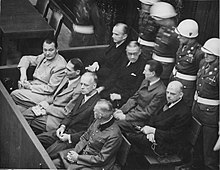
Eight of the 24 main defendants in Nuremberg: Göring, Hess, von Ribbentrop, Keitel (front row from left), Dönitz, Raeder, von Schirach, and Sauckel (behind).
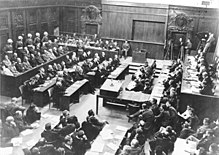
Trial hall (September 30, 1946): the changed arrangement of the judge's bench on the right; diagrams and films were shown on the front wall of the hall, seat for the witness; on the left, the bench of the defendants and their lawyers. In the foreground the tables of the plaintiffs, from left to right: Fr, UdSSR, USA, GB. The photograph was taken from the press gallery on the upper floor.
Previous story
Among the Allies of the anti-Hitler coalition, as well as all countries affected by World War II, there was a consensus, following recurring reports of "war crimes" and "atrocities," that individuals from the ruling class of the Nazi state would have to be punished. In October 1941, Churchill and Roosevelt declared that punishing Nazi crimes was one of their main wartime objectives. In the Moscow Declaration of November 1943, the three main Allies, Britain, the United States and the Soviet Union, agreed that war criminals should be tried in the states where they had committed their crimes (atrocities, massacres and executions). For so-called major criminals from the leadership circle, whose crimes could not be assigned to any particular geographical location, punishment was to be determined by a joint declaration of the Allies after the end of the war. There were differing opinions as to who was to be held responsible for which actions and how.
The UNWCC, in which the Soviet Union did not participate and which was supposed to absorb the prosecution pressure of the smaller countries from the St. James Declaration, collected cases of war crimes from 1943 onwards and worked out concepts for a legal prosecution of the main war criminals, which, however, did not come to a decision because Roosevelt and Churchill did not give the issue priority. Meanwhile, the Soviet Union, as the main victim of the barbaric Barbarossa campaign, had signaled with the Krasnodar and Kharkov war crimes trials that it would be interested in a publicized legal reappraisal.
When Churchill and Roosevelt agreed to Treasury Secretary Morgenthau's proposal for summary execution of the major war criminals at the Montreal Conference and leading UNWCC members resigned at about the same time, controversy arose in the United States during the ongoing presidential campaign with the War Department under Henry Stimson, who had long advocated further development of international law. After a heated controversy, the Montreal decision was not pursued further, but trials were to be held against the main war criminals.
After Truman took office, the United States took the initiative to come to an agreement with the Soviet Union, France and the United Kingdom. At the San Francisco Conference in early May 1945, a proposal was made to try the main war criminals, who had not yet been named, before an international military tribunal of the four victorious powers. After Soviet deliberation, the leading jurists exchanged views on how to proceed.
This cleared the way for a regular trial, for which the International Military Tribunal was specially established. It was to investigate, prove and punish the planning and conduct of a war of aggression, war crimes, crimes against the civilian population in the occupied territories as well as the atrocities in the Nazi concentration and extermination camps.
The London Quadripartite Agreement of August 8, 1945, which codified the legal basis of the trial of major war criminals and of which the Statute of the Military Tribunal is a part, was signed not only by the USA, Great Britain, France and the USSR. Greece, Denmark, Yugoslavia, the Netherlands, Czechoslovakia, Poland, Belgium, Ethiopia, Australia, Honduras, Norway, Luxembourg, Haiti, New Zealand, India, Venezuela, Uruguay and Panama also acceded to the agreement.
The process
The Soviet Union wanted the trials to be held in Berlin, but the fact that the Palace of Justice had remained largely undamaged and that a large prison, the Nuremberg Cellular Prison, was immediately adjacent was an argument in favor of Nuremberg. Nuremberg's importance as the city of the NSDAP Reich Party rallies and the site of the promulgation of the Nuremberg Laws was not a decisive factor in its choice as a venue for the trials, but it did lend it symbolic significance. The indictment, which had been signed by the prosecutors of the four Allied powers on October 6, 1945, was handed down on October 18, 1945, in the building of the Allied Control Council, in the only session held in Berlin. The actual trials, however, began in Nuremberg on 20 November 1945. On September 30 and October 1, 1946, the sentences were also pronounced there.
The judges
On the bench sat:
- Francis Beverley Biddle and John Johnston Parker (USA),
- Iona Nikitchenko and Alexander Volchkov (USSR),
- Sir Geoffrey Lawrence and Norman Birkett (United Kingdom) and
- Henri Donnedieu de Vabres and Robert Falco (France).
The court was chaired by Briton Lawrence, known for his circumspection, and the first session of the court in the Kammergericht building in Berlin was opened by Nikitchenko.
The accusers
The four principal accusers, who had also signed the indictment, were.
- Robert H. Jackson (USA),
- Roman Rudenko (USSR),
- Sir Hartley Shawcross (Great Britain) and
- François de Menthon, after his resignation Auguste Champetier de Ribes (France).
They used an extensive legal staff to represent the prosecution and move the trial along expeditiously.
The charges
The four charges were
- Formulation and execution of a common plan (conspiracy) to commit crimes against peace, the law of war and humanity (basis: Article 6 especially 6a of the Statute).
- Participation in the planning, preparation, unleashing and waging of wars of aggression in violation of international treaties, agreements and assurances (basis: Article 6a of the Statute).
- War crimes (stricto sensu) were crimes against members of enemy forces and the civilian population of occupied territories (basis: Article 6, especially 6b of the Statute). Crimes committed before the beginning of the war or against the civilian population of the Axis powers were not included.
- Crimes against humanity included the murder and persecution of members of the opposition and the murder, extermination, enslavement, deportation and other inhumane acts against civilian populations before or during the war (basis: Article 6, especially 6c of the Statute).
Item 1 in particular lists the seizure of power by the National Socialists and the transformation of Germany into a totalitarian dictatorship and preparations for war, as well as the breach of numerous international treaties and occupations of neighboring countries. Point 2 adds further wars. Crimes against civilians were charged under Count 3; the crimes of the Holocaust were tried under Count 4. Some of the crimes of the Holocaust, such as the murder of German Jews on Polish territory, are not only crimes against humanity, but also war crimes.
The four Allies divided the charges shortly after the London Conference. The Soviets and French had taken on the war crimes and crimes against humanity in Eastern and Western Europe, the British the charge of aggressive war, and the Americans took care of the plan for a joint "Nazi conspiracy" as well as the charge against so-called criminal organizations. The American chief prosecutor, Jackson, based on his experience in American antitrust trials, concentrated the presentation of evidence primarily on documentary evidence rather than on testimony that was media-savvy but open to attack. With some 4,000 documents drawn primarily from German archives, the prosecution was bolstered to prove "unbelievable events by evidence." The Soviet plan to conduct a show trial at an early stage yielded an extraordinary amount of evidence available to the Soviet prosecution team around Rudenko through the work of the Extraordinary State Commission.
The defendants
In selecting the defendants, the first problem was who could even be considered. Adolf Hitler and Joseph Goebbels were dead, as were Heinrich Himmler and Reinhard Heydrich. While the British, out of a deep-rooted skepticism about a legal solution, wanted to keep the group of people indicted small, the Americans, French, and Russians insisted on indicting a number of high-ranking military and business leaders as well. The availability of those to be indicted and their representativeness played a major role in the selection, and on August 29, agreement was reached on a joint list of 24 persons. In the case of Krupp there was a mix-up. Instead of Alfried Krupp von Bohlen und Halbach, his father, Gustav Krupp von Bohlen und Halbach, who was by then unable to stand trial, ended up on the indictment list and was therefore acquitted. Alfried Krupp was tried in the Krupp Trial in Nuremberg and sentenced in July 1948.
The US psychologist Gustave Mark Gilbert determined the intelligence quotients given in the following table using the Wechsler-Bellevue Intelligence Test. In order to clarify the personality structure, Gilbert conducted the Rorschach test and the Thematic Concept Test with 16 defendants.
| Overview of the accused persons | |||||||
| Image | Defendant | IQ | Defender | Charges | Guilty in | Judgment | Note |
|
| Martin BormannHead of | Frederick Bergold | 1,3,4 | 3,4 | death by hanging | in absentia, whereabouts unknown at the time (was in fact already dead) | |
|
| Karl DönitzCommander | 138 | Otto Kranzbühler | 1,2,3 | 2,3 | 10 years imprisonment | imprisoned until 1956 |
|
| Hans FrankGovernor General in the Generalgouvernement Poland | 130 | Alfred Seidl | 1,3,4 | 3,4 | death by hanging | executed on 16 October 1946 |
|
| Wilhelm FrickReichsminister of | 124 | Otto Pannenbecker | 1,2,3,4 | 2,3,4 | death by hanging | executed on 16 October 1946 |
|
| Hans FritzscheReichspropaganda Ministry | 130 | Heinz Fritz | 1,3,4 | - — | Acquittal | Subsequently sentenced to 9 years hard labour in a German Spruchkammer trial; amnestied 1950 |
|
| Walther FunkReichs Economic Minister | 124 | Fritz Sauter | 1,2,3,4 | 2,3,4 | life imprisonment | dismissed for health reasons in 1957 |
|
| Hermann GöringReichsluftfahrtminister | 138 | Otto Stahmer | 1,2,3,4 | 1,2,3,4 | death by hanging | Suicide on 15 October 1946 |
|
| Rudolf HeßDeputy | 120 | Günther von Rohrscheid, | 1,2,3,4 | 1,2 | life imprisonment | Suicide on 17 August 1987 (in custody) |
|
| Alfred JodlChief of the | 127 | Franz Exner, | 1,2,3,4 | 1,2,3,4 | death by hanging | executed on 16 October 1946 |
|
| Ernst KaltenbrunnerChief of the | 113 | Kurt Kaufmann | 1,3,4 | 3,4 | death by hanging | executed on 16 October 1946 |
|
| Wilhelm KeitelHigh Command of the Wehrmacht | 129 | Dr. Otto Nelte | 1,2,3,4 | 1,2,3,4 | death by hanging | executed on 16 October 1946 |
|
| Gustav Krupp von Bohlen und HalbachIndustrialist | 1,2,3,4 | - — | - — | abatement of action on health grounds | ||
|
| Robert LeyHead of the | 1,2,3,4 | - — | - — | Suicide on 25 October 1945 | ||
|
| Konstantin von NeurathAchief Protector | 125 | Otto von Lüdinghausen | 1,2,3,4 | 1,2,3,4 | 15 years imprisonment | dismissed for health reasons in 1954 |
|
| Franz von PapenVice Chancellor | 134 | Egon Kubuschok | 1,2 | - — | Acquittal | Subsequently sentenced to 7 years hard labour in a German Spruchkammer trial; released early in January 1949 |
|
| Erich RaederCommander-in-Chief | 134 | Walter Siemers | 1,2,3 | 1,2,3 | life imprisonment | dismissed for health reasons in 1955 |
|
| Joachim von Ribbentrop | 129 | Fritz Sauter, | 1,2,3,4 | 1,2,3,4 | death by hanging | executed on 16 October 1946 |
|
| Alfred RosenbergReichsminister | 127 | Alfred Thoma | 1,2,3,4 | 1,2,3,4 | death by hanging | executed on 16 October 1946 |
|
| Fritz SauckelGeneral Manager | 118 | Robert Servatius | 1,2,3,4 | 3,4 | death by hanging | executed on 16 October 1946 |
|
| Hjalmar SchachtReichsbank President | 143 | Rudolf Dix | 1,2 | - — | Acquittal | |
|
| Baldur von SchirachReichsjugendführer | 130 | Fritz Sauter | 1,4 | 4 | 20 years imprisonment | imprisoned until 1966 |
|
| Arthur Seyß-InquartReichsstatthalter | 141 | Gustav Steinbauer | 1,2,3,4 | 2,3,4 | death by hanging | executed on 16 October 1946 |
|
| Albert SpeerArmor Minister | 128 | Hans Flächsner | 1,2,3,4 | 3,4 | 20 years imprisonment | imprisoned until 1966 |
|
| Julius StreicherEditor Der Stürmer | 106 | Hans Marx | 1,4 | 4 | death by hanging | executed on 16 October 1946 |
| (1) conspiracy, (2) crimes against peace, (3) war crimes, (4) crimes against humanity. | |||||||
Tracking down the accused
In the chaos of the collapse, it was not easy to find the later defendants. Adolf Hitler and Joseph Goebbels had committed suicide before the end of the war. Heinrich Himmler, despite well forged papers, was arrested by the British during a check in May 1945 and committed suicide a few days later in Lüneburg. Heß had been a British prisoner since his "flight to England" in May 1941. Streicher had disguised himself as a painter and was arrested by US soldiers in Waidring at the end of May 1945 after a tip-off from the population. Schirach, who was presumed dead, initially went into hiding in Tyrol, but turned himself in at the beginning of June 1945. Göring went into captivity with his family and 17 trucks full of luggage in Austria in early May 1945 with the 7th US Army. Von Papen had already been tracked down by US soldiers in a hunting lodge near Meschede in early April 1945. Frank was arrested by American soldiers in Neuhaus am Schliersee in early May 1945. Kaltenbrunner was arrested by US soldiers at the Wildenseehütte near Altaussee on 12 May 1945. Seyß-Inquart was arrested in The Hague in May 1945 by members of the Canadian forces. Bormann, who remained missing, was tried in absentia. Several defendants were arrested in the special area of Mürwik near Flensburg, where the last Reich government had retreated in May 1945. Rosenberg was discovered on 18 May 1945 in the naval hospital there, Flensburg-Mürwik. On 23 May, the last Reich government, including Dönitz, Jodl and Speer, was arrested in the special area of Mürwik. Ribbentrop, who had also gone to Mürwik at the end of the war, had previously gone into hiding in Hamburg, where he was ultimately arrested in June 1945. It was not until 1998 that a DNA analysis proved beyond doubt that the skeleton found in 1972 near the Lehrter railway station in Berlin was Bormann's body and that he was therefore already dead before the end of the war.
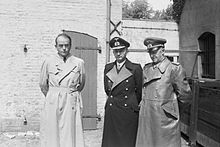
Speer, Dönitz and Jodl directly after their arrest at the police headquarters in Flensburg, where the scheduled press took photos (May 23, 1945)
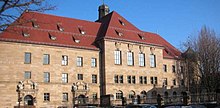
East building of the Palace of Justice Nuremberg (2007)
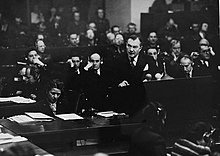
Robert H. Jackson as US Chief Prosecutor in Nuremberg
Questions and Answers
Q: What were the two sets of Nuremberg Trials?
A: The first set of Nuremberg Trials were organized by the International Military Tribunal (IMT) and involved the leaders of Nazi Germany. The second set of trials, known as the follow up trials, were held in the same courtroom but run by the Americans alone and involved lower-ranking Nazis, like doctors and officials from the German Foreign Office.
Q: Who organized the first set of Nuremberg Trials?
A: The first set of Nuremberg Trials was organized by the International Military Tribunal (IMT).
Q: Who judged and prosecuted during these trials?
A: During these trials, judges and prosecutors came from France, USSR, United Kingdom and United States.
Q: Who ran the follow up trials?
A: The follow up trials were run solely by Americans.
Q: What type of people were tried in these follow up trials?
A: These follow up trials involved groups of lower-ranking Nazis such as doctors and officials from German Foreign Office.
Q: Where did both sets of Nuremberg Trials take place?
A: Both sets of Nuremberg Trials took place in a single courtroom.
Search within the encyclopedia

_A14899.jpg)




.jpg)
















